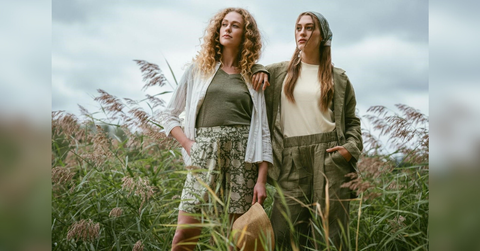 NEWS
NEWSBeyond Fast Fashion: Why Living Crafts’ Timeless Basics Are Here to Stay

Nov. 21 2025, Published 1:08 a.m. ET
There is a memory many carry, whether they grew up in Berlin, Boston, or Bogotá: a drawer that smells faintly of lavender or cedar, filled with clothes that last. A wool sweater inherited from a parent, its elbows patched but its form still intact. Socks darned by hand, worn not because they were new but because they had been faithful. These are not the clothes of the algorithmic age - purchased at midnight on a phone, arriving in a cardboard box by morning, destined for landfill by year’s end. They are the clothes of patience and continuity, a reminder that fashion was once about stewardship, not speed.
In Germany, nestled in the small town of Selbitz, Living Crafts GmbH has spent forty years trying to hold onto that memory. Long before “eco-fashion” was a marketing hook, Living Crafts was weaving organic cotton into socks in a garage. Today, under Managing Director Frank Schell, the company serves over 200,000 customers across Europe and beyond, generating €12 million annually and growing by 15 percent year over year. But its mission remains rooted in that same drawer of timeless basics: make garments that endure, both in the closet and in the conscience.
The Illusion of Speed
Fast fashion’s allure has always been its velocity. Clothes appear, disappear, and reappear with a kind of manic abundance. According to recent figures, the global apparel market was worth more than $1.3 trillion in 2023 and is expected to climb steadily to $1.78 trillion by 2030. But much of that growth comes at a price: the industry is responsible for nearly 10 percent of global carbon emissions, not to mention devastating labor practices from Dhaka to Delhi.
Living Crafts resists this treadmill. Its products, such as socks, nightwear, basics for men and women, are not built to flatter an algorithm but to withstand seasons. “We believe quality is back in fashion,” Schell has said. “Durability is what people want again. Fashion should please for longer than a season.” This is not nostalgia but a deliberate rebuke to the culture of disposability.
Sustainability as a First Principle
The company’s approach to sustainability is not decoration; it is doctrine. Every garment carries GOTS certification, verifying that it was made with organic fibers and under fair conditions. Living Crafts also invests in climate neutrality, compensating emissions with certified partners. The goal is not perfection, but accountability—recognizing that fashion can never be impact-free, only more responsible.
In practice, this means refusing shortcuts. While competitors flood the market with polyester blends and synthetics, Living Crafts insists on cotton, wool, and linen, sourced for both softness and sustainability. It means acknowledging that organic textiles will always cost more to produce, but committing to keeping them affordable enough that eco-fashion does not become the preserve of the elite. “High-quality clothing can only make a difference if it goes from exception to rule,” Schell notes.
Want OK! each day? Sign up here!
Fashion as Memory, Fashion as Future
What Living Crafts offers is not simply apparel but a way of rethinking consumption. In a world where Germans now buy groceries online as often as they once bought books, and where 34 percent of consumers cite sustainability as a central factor in their purchases, the company represents a shift from spectacle to substance. It suggests that people no longer want just the thrill of the new; they want the security of the enduring.
The brand’s 40th anniversary is not a coronation but a crossroads. The next decade will be defined by whether sustainability can scale, whether brands like Living Crafts can move from niche to norm. Industry forecasts suggest e-commerce in Europe will continue to grow by nearly 9 percent annually, but much of that growth will be captured by players willing to compromise values for volume. For Living Crafts, the challenge is to prove that ethical fashion can grow without surrendering its integrity.
A Future Sewn with Care
Clothing is never just clothing. It is a statement about what kind of world we want to live in, what we value, what we discard, and what we choose to remember. Living Crafts’ basics are quiet garments, but in their quietness lies a defiance: against waste, against exploitation, against the idea that beauty must be fleeting.
“Making every day special, that is our goal,” Schell reflects. That insistence on the everyday, on garments that survive the wash, the wear, and the years, is radical. Forty years in, Living Crafts offers not just clothes but a proposition: that fashion’s future belongs to those willing to slow down, to stitch patience into fabric, and to believe that timelessness, not speed, is what endures.

